685 Search Results for model
September 4, 2014
by Carole Zangari -
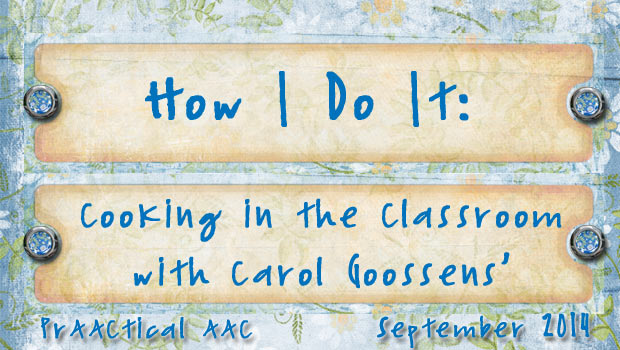
There is something about fall that puts us in the mood for cooking. Today, we are honored to learn from an AAC pioneer, Dr. Carol Goossens,’ who is an SLP and special educator based in the New York City area. She has consulted extensively in a variety of classrooms serving the full spectrum of children with special needs. Carol has presented both nationally and internationally about her collaborative work with teachers, therapists and families. She is known for her ability to seamlessly integrate technology in the classroom and for developing innovative ways to help children learn …while having fun doing it! In this post, she shares one of her latest projects, making animated recipes for using in cooking activities in the classroom. Cooking appears to be motivating for most children … the magic of putting together ingredients that ultimately become something delicious to eat. Teachers, speech-language pathologists (SLPs) and occupational therapists (OTs) often use food preparation activities... [Read More...]
August 28, 2014
by Carole Zangari -
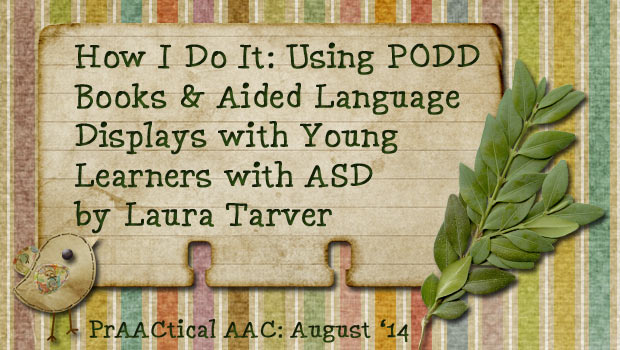
Today, we turn to the UK in a guest post by Laura Tarver. a London-based Speech and Language Therapist working with children with ASD and other complex needs. She previously worked in a primary school for children with ASD, where PODD and Aided Language Displays were introduced as part of a school wide approach in order to enhance the communication-friendly environment for all pupils. In this post, she shares how they used PODD books and aided language input to build the students’ communication skills. :::::::::::::::::::::::::::::::::::::::::::::::::::::::::::::::::: PODD (or Pragmatic Organisation Dynamic Display) communication books were developed in Australia by Gayle Porter, originally for children with cerebral palsy. As their use becomes more widespread throughout the world, practitioners are considering the benefits of using them with other clinical populations. Their structured organisation and emphasis on visual communication means that they are also a valuable tool for developing the communication of those with... [Read More...]
August 14, 2014
by Carole Zangari -

We got this question from an SLP who recently helped a young adult get funding for a speech generating device (SGD): Should we put symbols for yes and no on the student’s communication device? Like other things in clinical practice, it depends of the specifics of the situation. In this case, she wanted to start out with a very small vocabulary set and build gradually. That sure makes sense, but where she got stuck was with which specific words to include. Team members were encouraging her to include yes and no, hence the question. There is no one-size-fits-all answer for this. Here are some things we think about in making that decision for and with an AAC learner. Does he/she have another way to say yes/no? If so, then this may not be the best use of the limited ‘real estate’ on the learner’s SGD. In the case of this... [Read More...]
July 31, 2014
by Carole Zangari -
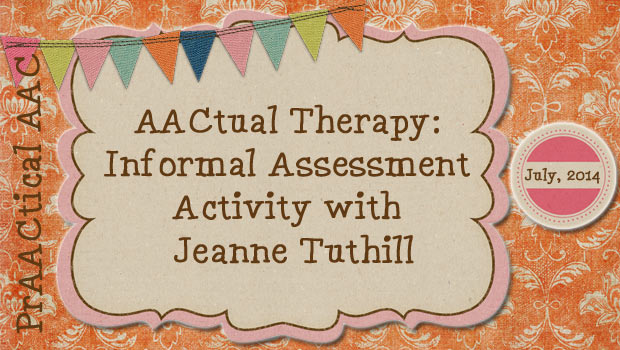
We are so pleased to have a return visit by SLP Jeanne Tuthill. In this post, she shares an informal assessment activity based around a Book of Favorites. Enjoy! ::::::::::::::::::::::::::::::::::::::::::::::::::::::::::::::::::::::::: Greetings from Massachusetts! My work at the Collaborative for Educational Services is on a school-year contract so I’m currently on summer break with my three girls. We’ve been plenty busy with fun summer activities but my learning and growing as an AAC therapist isn’t tied to my contract dates. I’ve also been busy watching webinars, reading some great books (educational as well as pleasure-reading), and following the Facebook feeds of some of my favorite AAC peeps! I really wish I could have attended ISAAC in Lisbon, Portugal this year…I loved seeing everyone’s photos and posts from what looked to be a spectacular conference! In my last post on assessment I shared with you an ice-breaker activity that is low-stress for... [Read More...]
June 30, 2014
by Carole Zangari -
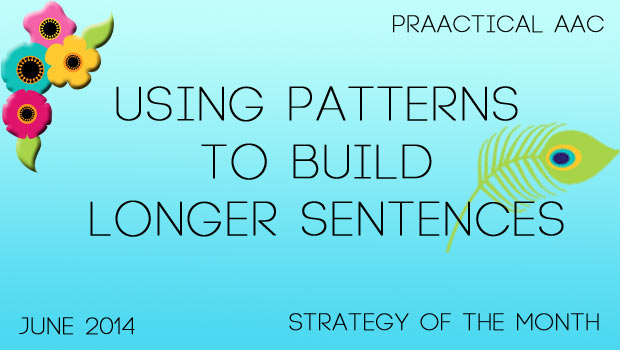
Throughout the month, we’ve been talking about building sentence length and complexity. We’ll end the month with a concept that applies to both beginning communicators and those with more complex language skills. Human beings are pattern-seekers. We notice similarities and distinctions, and compare things that are new to us to things we already know about. As we go through our lives, we draw on our pattern-seeking skills to learn about and understand the world. How can we use this intrinsic trait to help us in teaching language to AAC learners? Consider patterns when choosing your targets: Increasing sentence length is a broad goal that gives us lots of flexibility in how we design our intervention. We can lengthen sentences by adding descriptors, temporal terms, conjunctions, embedded clauses, and more. Within each category, there are many options. For a beginning communicator, we might teach descriptors related to appearance (e.g., size, color,... [Read More...]
June 27, 2014
by Carole Zangari -
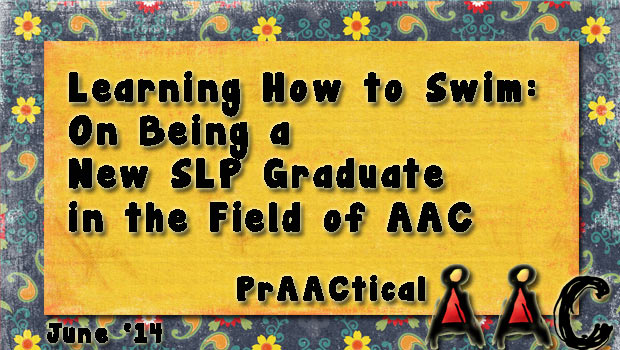
We’re pleased to welcome a new guest blogger, Kate Munro, to our pages today. I first ‘met’ Kate on Twitter (@SpeechieKate) and was even more excited by her passion for AAC when I met her in person last month. Her passion for AAC began during a clinical placement while training at the University of Queensland. This snowballed when completing her honours with Dr. Bronwyn Hemsley on health professional’s views on communication in hospital for children with Cerebral Palsy and CCN. Now living in South Australia, she is a speech pathologist working at Two Way Street, a private practice which specialises in AAC. In addition to this, she tutors students at Flinders University’s Disabilitiy and Community Inclusion Unit and volunteers her time as the South Australian Representative for AGOSCI. Since her honours research was published as part of a larger study, she has developed a greater interest in research but isn’t ready... [Read More...]
June 9, 2014
by Robin Parker -
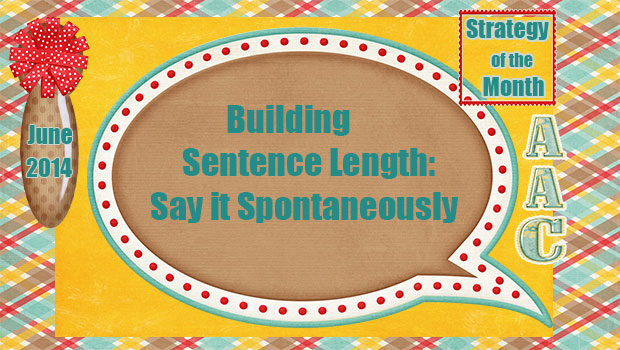
As beginning communicators start using single symbols to communicate, the next step immediately becomes to expand sentence length to two words, then three words, then more. Helping learners to use longer sentences spontaneously is the main goal. Teaching spontaneous use of longer sentences helps assure that those sentences can be used with many communication partners and in many contexts. A great facilitator strategy for helping to build sentences is ‘add a word’ or expansions and extensions. This was mentioned in last week’s post: Helping Beginning Communicators Expand Their Sentence Length but is further delineated below. What is it? ‘Add a word’ strategy is more formally called expansions and extensions. Expansions typically refer to adding a word with new conceptual knowledge while extensions add a word with new grammatical information. Expansions and extensions are a form of modeling and can be done both on a communication display as well as verbally. This... [Read More...]
June 2, 2014
by Carole Zangari -
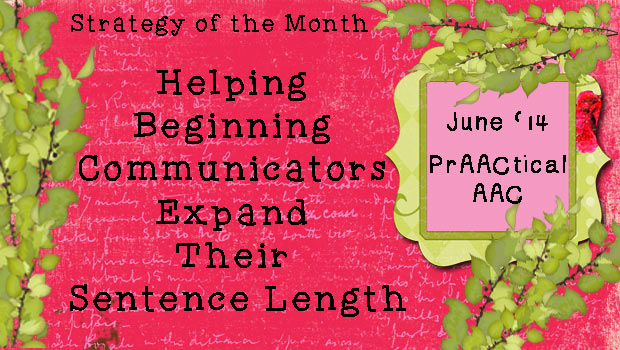
Nothing makes an AAC SLP happier than seeing beginning communicators start to use symbols to express themselves. Sure, it is great when a learner grabs your arm to lead you to the snack cupboard or hands you a juice box to get help opening it. Those are important communicative acts that we celebrate. But moving beyond pre-symbolic forms of communication to using signs and pictures, allows us to expand their vocabularies outside of the ‘here and now’ and enables them to communicate effectively with less familiar partners. When we’ve crossed the bridge into symbolic communication, we’re building a foundation for language development. If things go well, the learner will steadily acquire new symbols and words, eventually allowing us to work on word combinations. Are you working with AAC learners who at the early sentence level? If so, you may be considering how to build the length and complexity of their... [Read More...]
May 30, 2014
by Robin Parker -
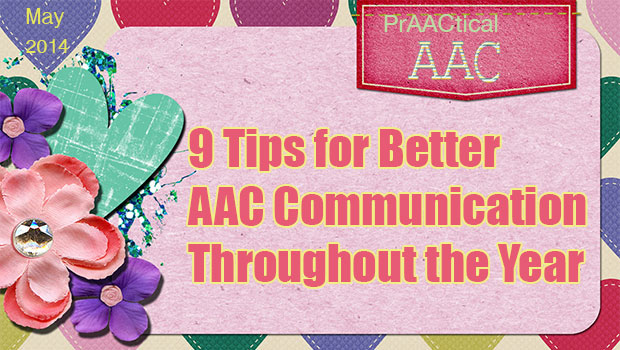
Although Better Hearing and Speech Month is ending, we want to continue best prAACtices in all teaching interactions throughout the year. Here are 9 AAC facilitator tips to help with this goal. Provide Aided Language Input (ALI)– ALI is modeling AAC style. Speak AAC to the AAC user. Use Scaffolding– Scaffolding is a verbal and visual strategy that has the facilitator build upon prior knowledge of the learner in order for the learner to integrate a new concept or skill. Model words and concepts to add information onto what the AAC user already knows and uses. Provide Expansions and Extensions– A form of modeling. Add a word to the spontaneous communication from the learner. The facilitator models a conceptual or grammatical word in the form of a model. Use Recasting– Recasts serve to add or correct information without obstructing the natural flow of communication. Recasting is another form of modelling. The... [Read More...]
May 21, 2014
by Carole Zangari -
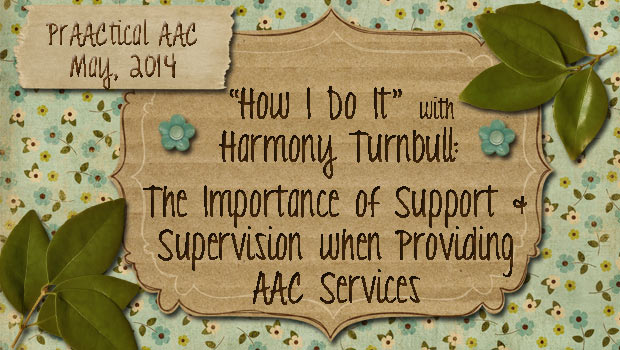
We are so thrilled to have a guest post today, from Australian SLP Harmony Turnbull. Harmony is a Consultant Speech Pathologist for Ageing, Disability and Home Care in NSW, Australia. In her role, she provides support and supervision to senior speech pathologists, carries a small caseload of people with complex needs and provides expert consultancy for management. She has specialised in supporting people with disabilities including complex communication needs for 11 years and is addicted to networking. She can often be found sharing her knowledge and asking many questions on Facebook and Twitter (@SP_Harmony). Harmony is passionate about the work speech/language pathologists can do to improve the quality of life for people with disabilities. The Importance of Support and Supervision when Providing AAC Services Scenario – Jane Jane is an SLP who has been working with people with disabilities for over 5 years, including people with complex communication needs. Her caseload... [Read More...]









